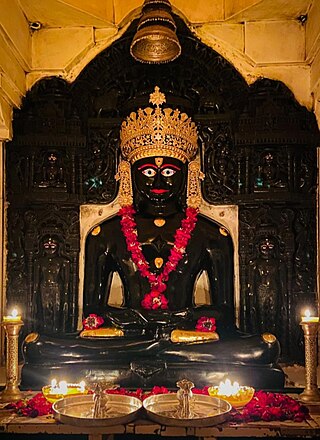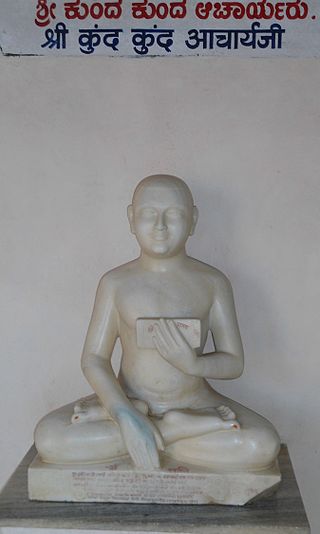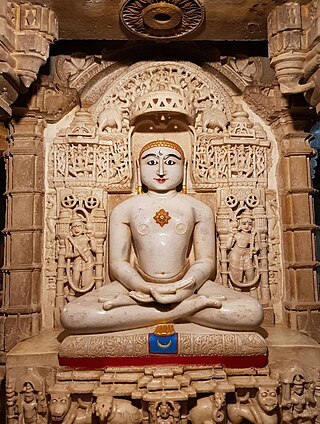
In Jainism, a Tirthankara is a saviour and supreme preacher of the dharma. The word tirthankara signifies the founder of a tirtha, a fordable passage across saṃsāra, the sea of interminable birth and death. According to Jains, tirthankaras are the supreme preachers of dharma, who have conquered saṃsāra on their own and made a path for others to follow. After understanding the true nature of the self or soul, the Tīrthaṅkara attains kevala jnana (omniscience). A Tirthankara provides a bridge for others to follow them from saṃsāra to moksha (liberation).

Sambhavanatha was the third Jain tirthankara of the present age (Avasarpini). Sambhavanatha was born to King Jitari and Queen Susena at Shravasti. His birth date was the fourteenth day of the Margshrsha shukla month of the Indian calendar. Like all arihant, Sambhavanatha at the end of his life destroyed all associated karmas and attained moksha (liberation).

Sumatinatha was the fifth Jain Tirthankara of the present age (Avasarpini). Sumatinatha was born to a Kshatriya King Megha (Megharatha) and Queen Mangalavati (Sumangalavati) at Ayodhya in the Ikshvaku dynasty. His Janma Kalyanak (birthday) was the eighth day of the Vaisakha Sudi month of the Jain calendar.

Suparshvanatha, also known as Suparśva, was the seventh Jain Tīrthankara of the present age (avasarpini). He was born to King Pratistha and Queen Prithvi at Varanasi on 12 Jestha Shukla in the Ikshvaku clan. He is said to have attained moksha at Shikharji on the sixth day of the dark half of the month of Phālguna.

Śāntinātha or Śānti is the sixteenth Tīrthaṅkara of Jainism in the present age. According to traditional accounts, he was born to King Vishvasena and Queen Aćira of the Ikshvaku dynasty in the north Indian city of Hastinapur. His birth date is the thirteenth day of the Jyest Krishna month of the Indian calendar. He was also a Chakravarti and a Kamadeva. He ascended to the throne when he was 25 years old. After over 25,000 years on the throne, he became a Jain monk and started his penance.

Mallinatha was the 19th tīrthaṅkara "ford-maker" of the present avasarpiṇī age in Jainism.

Naminatha was the twenty-first tirthankara of the present half time cycle, Avsarpini. He was born to the King Vijaya and Queen Vipra of the Ikshvaku dynasty. King Vijaya was the ruler of Mithila at that time. Naminatha lived for 10,000 years. When Naminatha was in his mother's womb, Mithila was attacked by a group of powerful kings. The aura of Naminatha forced all the kings to surrender to King Vijaya.

Nemināth, also known as Nemi and Ariṣṭanemi, is the twenty-second tirthankara of Jainism in the present age. Neminath lived 81,000 years before the 23rd Tirthankar Parshvanath. According to traditional accounts, he was born to King Samudravijaya and Queen Shivadevi of the Yadu dynasty in the north Indian city of Sauripura. His birth date was the fifth day of Shravan Shukla of the Jain calendar. Krishna, who was the 9th and last Jain Vasudev, was his first cousin.

King Nabhi or Nabhi Rai was the 14th or the last Kulakara of avasarpini. He was the father of Rishabhanatha, the first tirthankara of present avasarpini. According to Jain text Ādi purāṇa, Nabhirāja lived for 1 crore purva and his height was 525 dhanusha.

Varanga is a village in Karkala Taluk in Udupi district of Karnataka, India. According to the 2011 census, it has a population of 4,011. This village is an important Jain center.
According to the Jain cosmology, the Śalākāpuruṣa "illustrious or worthy persons" are 63 illustrious beings who appear during each half-time cycle. They are also known as the triṣaṣṭiśalākāpuruṣa. The Jain universal or legendary history is a compilation of the deeds of these illustrious persons. Their life stories are said to be most inspiring.

Digambara is one of the two major schools of Jainism, the other being Śvetāmbara (white-clad). The Sanskrit word Digambara means "sky-clad", referring to their traditional monastic practice of neither possessing nor wearing any clothes.

Jain sculptures or Jain idols are the images depicting Tirthankaras. These images are worshiped by the followers of Jainism. The sculpture can depict any of the twenty-four tirthankaras with images depicting Parshvanatha, Rishabhanatha, or Mahāvīra being more popular. Jain sculptures are an example of Jain art. There is a long history of construction of Jain sculptures. Early examples include Lohanipur Torsos which has been regarded to be from the Maurya period, and images from the Kushan period from Mathura.

Ajitanatha was the second tirthankara of the present age, avasarpini according to Jainism. He was born to king Jitashatru and Queen Vijaya at Ayodhya in the Ikshvaku dynasty. He was a liberated soul which has destroyed all of its karma.

Abhinandananatha or Abhinandana Swami was the fourth Tirthankara of the present age (Avasarpini). He is said to have lived for 50 lakh purva. He was born to King Sanvara and Queen Siddhartha at Ayodhya in the Ikshvaku clan. His birth date was the second day of the Magh shukla month of the Indian calendar. According to Jain beliefs, he became a siddha, a liberated soul which has destroyed all of its Karma.

Chandraprabha or Chandranatha is the eighth Tirthankara of Tīrthaṅkara of Jainism in the present age. According to traditional accounts, he was born to King Mahasena and Queen Lakshmana Devi at Chandrapuri to the Ikshvaku dynasty. According to Jain texts, his birth-date was the twelfth day of the Posh Krishna month of the Indian calendar. He is said to have become a siddha, a liberated soul which has destroyed all of its karma.

Aranath(Arnath) was the eighteenth Jain Tirthankar of the present half cycle of time (Avasarpini). He was also the eighth Chakravartin and thirteenth Kamadeva. According to Jain beliefs, he was born around 16,585,000 BCE. He became a siddha i.e. a liberated soul which has destroyed all of its karmas. Aranath was born to King Sudarshana and Queen Devi (Mitra) at Hastinapur in the Ikshvaku dynasty. His birth date was the tenth day of the Migsar Krishna month of the Indian calendar.

Dharmanatha was the fifteenth Jain Tirthankara of the present age (Avasarpini). According to Jain beliefs, he became a siddha, a liberated soul which has destroyed all of its karma. Dharmanath was born to King Bhanu Raja and Queen Suvrata Rani at Ratnapuri in the Ikshvaku dynasty. His birth date was the third day of the Magh Sukla month of the Indian calendar.

In Jainism, Bharata was the first chakravartin of the Avasarpini. He was the eldest son of Rishabhanatha, the first tirthankara. He had two sons from his chief-empress Subhadra, named Arkakirti and Marichi. He is said to have conquered all six parts of the world and to have engaged in a fight with Bahubali, his brother, to conquer the last remaining city of the world.

The Lakshmeshwara Jain temples is a group of Jain temples in the town of Lakshmeshwara in the Gadag district of Karnataka.




























